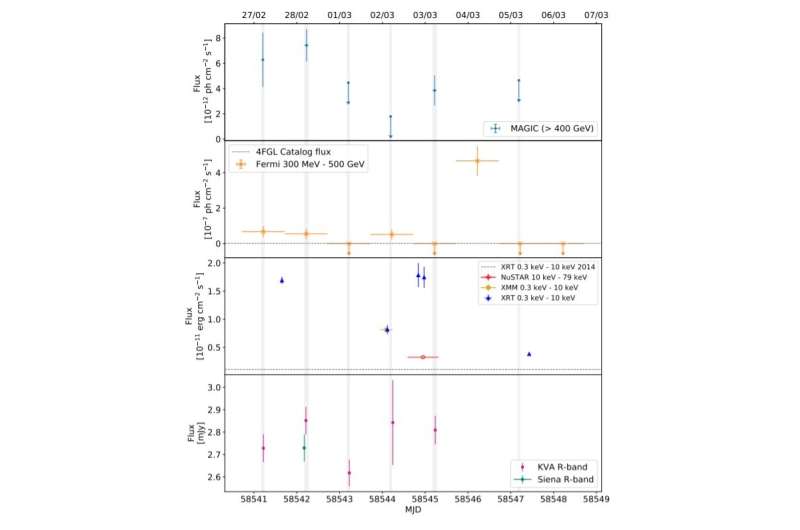Scientists have detected a record-breaking blip of high-energy radiation from a collapsing star.

Using NASA's Fermi Gamma-ray Space Telescope, astronomers picked up what is known as a gamma-ray burst, or GRB, that had raced towards Earth from deep space. It has been named GRB 200826A.
GRBs are typically created when something incredibly energetic happens somewhere in space, and are divided into two types—long GRBs and short GRBs.
Short GRBs are generated when two dense stars, or even a star and a black hole, join together in an event that can be as rapid as two seconds or less. Long GRBs are generated when massive stars collapse.
But GRB 200826A, detected in August 2020, surprised scientists because it was short but also appears to have come from the collapse of a star.
It's thought to be the shortest GRB ever detected that has been produced in this way.
It was also incredibly powerful. The amount of energy emitted by that single gamma-ray burst was equal to all of the energy released by the entire Milky Way galaxy over the same time period—multiplied by 14 million times.
Tomás Ahumada, a doctoral student at the University of Maryland who co-authored a research paper about GRB 200826A, said it was one of the most energetic short-duration GRB's ever documented.
Stars collapse when they run out of hydrogen—the fuel that keeps them burning. Without this fuel, they begin to fall into themselves because of their huge internal mass.
As the material inside the star rushes in on itself, it releases two powerful jets of radiation in opposite directions. If one of these jets is pointed directly at the Earth, scientists can detect it with specially-designed telescopes and work out where in the universe it came from.
After detecting GRB 200826A, astronomers studied the patch of sky the burst seemed to have come from and saw that it came from a galaxy 6.6 billion light years away, meaning the gamma-ray burst would have taken around half the age of the universe to reach us.
The astronomers also found the afterglow from the star's collapse, known as a supernova, which suggested the source of the GRB was indeed a collapsing star and not a binary merger event typically associated with short GRBs.
The shortness of the burst also suggests that the star only just managed to produce them, which may help scientists explain why they spot many more supernovae than they do GRBs. Ahumada's report, published in the journal Nature Astronomy on Monday, concludes: "Our discovery is consistent with the hypothesis that most collapsars fail to produce ultra-relativistic jets."
Very-high energy gamma-ray emission detected from blazar TXS 1515–273

An international team of astronomers has carried out multi-wavelength observations of a blazar known as TXS 1515–273; they detected very-high energy (VHE) gamma-ray emission from this source for the first time. The finding is detailed in a paper published July 20 on arXiv.org.
Blazars, classified as members of a larger group of active galaxies that host active galactic nuclei (AGN), are the most numerous extragalactic gamma-ray sources. Their characteristic features are relativistic jets pointed almost exactly toward the Earth. Based on their optical emission properties, astronomers divide blazars into two classes: flat-spectrum radio quasars (FSRQs) that feature prominent and broad optical emission lines, and BL Lacertae objects (BL Lacs), which do not.
At a redshift of 0.1285, TXS 1515–273 is a blazar of BL Lac class. Previous observations of this object found that it has a photon index of about 2.0, which suggests that it may be an extreme high frequency-peaked blazar (EHBL). In general, EHBLs are excellent targets to search for new extragalactic VHE gamma-ray emission.
In the beginning of 2019 a flaring activity in the high-energy (HE) gamma-ray band started from TXS 1515–273. Hoping to detect VHE gamma-ray emission, a team led by researchers from the Major Atmospheric Gamma-ray Imaging Cherenkov (MAGIC) telescope collaboration commenced a multi-wavelength observational campaign of this source.
"A MWL [multi-wavelength] campaign on TXS 1515–273 was organized at the end of February 2019. During the flaring activity, the source was observed in different energy bands, ranging from radio to VHE gamma rays. Simultaneous or quasi-simultaneous observations were carried out by KVA, Swift, XMM, NuSTAR and MAGIC in order to investigate the location of the SED [spectral energy distribution] peaks and look for evidence of extreme behavior during the flare," the astronomers wrote in the paper.
MAGIC observed TXS 1515–273 between February 27 and March 5, 2019, which resulted in a significant detection of this blazar in the VHE gamma-ray band. The average integral VHE flux of TXS 1515–273 was measured to be approximately 6 percent of the Crab nebula flux above 400 GeV.
The astronomers detected an hour-scale variability in the X-ray fluxes of TXS 1515–273 and a clear change in the spectral shape between XMM-Newton and NuSTAR observations. The data from the X-ray variability timescales allowed the team to determine the synchrotron peak frequency of the blazar. The results suggest that the source is a flaring high, but not extreme, synchrotron peaked object.
Studying the jet of TXS 1515–273, the researchers found no new components or moving components. This is consistent with what is generally seen in other TeV blazars with high synchrotron peak frequency.
As part of the study, the scientists also modeled the broadband SED from radio to VHE gamma rays.
"We applied a simple one-zone model, which could not reproduce the radio emission and the shape of the optical emission, and a two-component leptonic model with two interacting components, enabling us to reproduce the emission from radio to VHE band," the authors of the paper explained.
© 2021 Science X Network
No comments:
Post a Comment